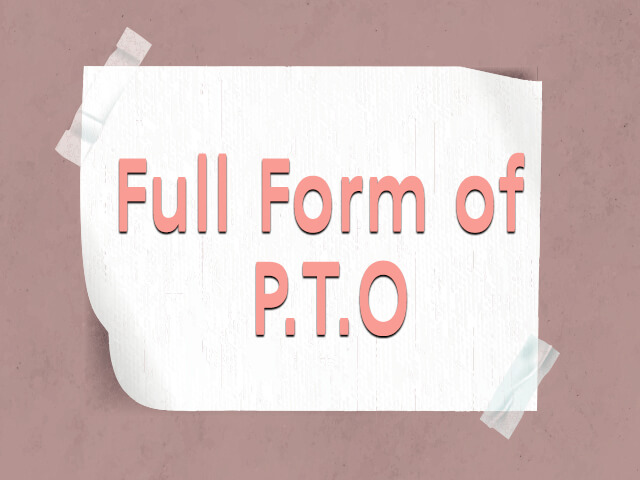P.T.O Stands for
The most famous full form of P.T.O are the following two full forms:
1) P = Please
T= Turn
O=Over
2) P = Paid
T = time
O = Off
first, let us discuss the most widely used full from
What is P.T.O Full Form?

Please Turn Over(P.T.O):
P.T.O means Please Turn Over you will find P.T.O written at the bottom of the page in the right corner. It is used to show the reader that the information written on the page is not over yet there is some information left on the other side of the page hence Please Turn Over the page i.e P.T.O.
This short-form P.T.O is wide while writing the agreement, Application, Contract, and other official documents. The student can also use P.T.O short form in the answer paper suppose they are writing a long answer which includes a definition, explanation, and diagram.
Suppose he writes definition, and explanation, and there are just four lines left to draw a diagram he will leave that four-line empty and draw a diagram on the next page, and in the bottom right of the previous page, he will write P.T.O which means please turn over the page. To let the reader know that additional information is given on another page.
Paid Time Off(P.T.O):
Paid time off or personal time off(P.T.O) is the policy adopted in some government and private offices that provide a bank of hours in which an employee pools sick leaves and vacation time giving employees the flexibility to select the type of time off they desired.
In a month or in a year the employee of the government or private office can take a certain amount of leaves for which his salary will not be deducted in general there are paid leaves the numbers of days and hours for which salary is not deducted is decided by P.T.O policy of company or government. P.T.O policy has its own benefits and drawbacks. They are as follows.
Benefits of PTO:
- In P.T.O policy both sick leaves and vacation time are predetermined by the corporation if a person takes fewer sick leaves then he can take more vacation time and vice versa hence great flexibility is maintained.
- An employee can use balance time under P.T.O as an emergency arises without getting his salary deducted.
- P.T.O policy is a very good requirement initiative to attract employees.
- P.T.O helps to maintain a work-life balance.
Disadvantages of PTO:
- when the employee quits their job midway management still has to pay him for paid leaves.
- More than one employee may want to take a day off on the same day at the end of the year in order to avoid losing the paid time off hours. That may result in a shortage of staff.
- Sometimes employees may use all the leaves that come under P.T.O as vacation days and then come to work when they are sick.
Questions to ask about PTO
Ans: The long form of P.T.O are as follows
P.T.O- Please Turn it Over.
P.T.O- Paid time off.
P.T.O- pretty tractor Operator.
P.T.O- Public telephone Operator.
P.T.O- Please turn it off.
P.T.O- Power Test Operation.
Ans: The P.T.O is used at the bottom right corner of official letters.
Ans: It is used to inform the reader that the document contains some additional information on another side of the page.
Ans: The paid time off policy is adopted by a corporation to maintain the work-life balance of the employee.
Ans: The other name of Paid time off is Personal time off.




